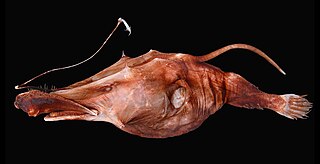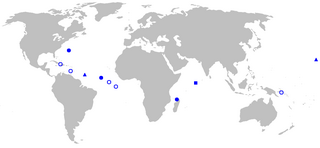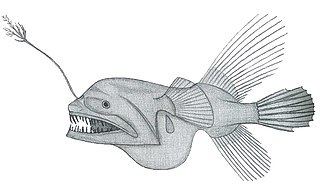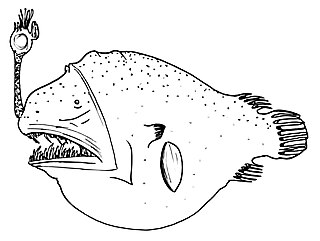
Leftvents are small, deep-sea lophiiform fish comprising the family Linophrynidae distributed throughout tropical to subtropical waters of all oceans.

The footballfish form a family, Himantolophidae, of globose, deep-sea anglerfishes found in tropical and subtropical waters of the Atlantic, Indian, and Pacific Ocean. The family contains 23 species, all of which are classified in a single genus, Himantolophus.

Certaiidae, the warty sea devils, caruncled seadevils or seadevils, are a family of marine ray-finned fishes belonging to the suborder Ceratioidei, the deep-sea anglerfishes, in the anglerfish order Lophiiformes. The warty sea devils are sexually dimorphic with the small males being obligate sexual parasites of the much larger females. The fishes in this family are widely distributed from polar to tropical seas around the world.
Thaumatichthyidae, the wolftrap anglers, is a small family of marine ray-finned fishes, also called the wolftrap seadevils, classified within the suborder Ceratioidei, the deep-sea anglerfishes. They have distinctive upper jaws with movable premaxillaries that can be lowered to form a cage-like trap around the much shorter lower jaw.

The triplewart seadevil is a sea devil of the family Ceratiidae and the order Lophoiiformes. This species is the only member of its genus. Noted for its extreme sexual dimorphism, the triplewart seadevil's length ranges from 20 to 30 cm for females and 1 to 3 cm for males.
Bertella is a monospecific genus of marine ray-finned fish belonging to the family Oneirodidae, the dreamers, a family of deep sea anglerfishes. The only species in the genus is Bertella idiomorpha and this can be distinguished from other members of the family by the structure of its hyomandibular bone.

The horned lantern fish or prickly seadevil is a species of marine ray-finned fish, it is the only species in the monotypic family Centrophrynidae. This species has a circumglobal distribution and is distinguished from other deep-sea anglerfishes by various characters including four pectoral radials, an anterior spine on the subopercular bone, and a short hyoid (chin) barbel in both sexes.

The toothed seadevil, spiny seadevil or netbeard seadevil,, is a rarely seen deep-sea anglerfish found in the mesopelagic and bathypelagic zones in Oceans around the World. It is the only species in the family Neoceratidae, and is unique amongst the deep-sea anglerfish in lacking an illicium and esca, and in having large teeth placed on the outside of its jaws.
Prince Axel's wonderfish is a bottom-dwelling deep-sea anglerfish of the family Thaumatichthyidae. Thaumatichthys axeli lives at a depth of around 3,600 meters, deeper than any other member of the genus Thaumatichthys. As with other members of the family, they possess a distinctive forked light organ inside their mouth, which they use to lure prey. Large, curved teeth "fringe the upper jaw like a comb". Specimens have been found measuring up to about 50 cm.

Thaumatichthys binghami is a species of wolftrap angler known from the western central Atlantic Ocean, where it occurs at a depth of 2,532 metres (8,307 ft). This species is similar to T. axeli, except that its esca bears 2–3 pairs of lateral lobes that are elongated into tapering filaments in the largest individuals, and the uppermost medial appendage on the esca is finger-like and tapering.

The complete anglerfish (Lasiognathus) is a genus of deep-sea anglerfish in the family Thaumatichthyidae, with six species known from the Atlantic and Pacific Oceans. Its lure apparatus appears to consist of a fishing rod, a fishing line, bait, and hooks. It is also distinctive for an enormous upper jaw with premaxillaries that can be folded down to enclose the much shorter lower jaw.

The anglerfish are fish of the teleost order Lophiiformes. They are bony fish named for their characteristic mode of predation, in which a modified luminescent fin ray acts as a lure for other fish. The luminescence comes from symbiotic bacteria, which are thought to be acquired from seawater, that dwell in and around the sea.

Black seadevils are small, deepsea lophiiform fishes of the family Melanocetidae. The five known species are all within the genus Melanocetus. They are found in tropical to temperate waters of the Atlantic, Indian, and Pacific Oceans, with one species known only from the Ross Sea.

The humpback anglerfish is a species of black seadevil in the family of Melanocetidae, which means "black whale" in Greek. The species is named after James Yate Johnson, the English naturalist who discovered the first specimen in Madeira in 1863. The common names include anglerfish, viperfish and fangtoothfish.

Rhynchactis is a genus of deep-sea anglerfish in the family Gigantactinidae, containing three species found worldwide at depths greater than 400 m (1,300 ft). Adult female Rhynchactis reach a standard length (SL) of 11–13 cm (4.3–5.1 in) and have a dark-colored, streamlined body and a relatively small head bearing a very long illicium. Unlike almost all other deep-sea anglerfishes, the illicium bears no bioluminescent esca at the tip. The mouth is almost devoid of teeth, and the inside of both jaws are covered by numerous white glands that are unique to this genus.

Caulophryne polynema is a species of marine ray-finned fish belonging to the family Caulophrynidae, the fanfins. This species is a deepwater species which is found in the Atlantic and Pacific Oceans. Like other deepwater anglerfishes it shows extreme sexual dimorphism with the males being much smaller than the females and acting as sexual parasites of the females.
Microlophichthys is a genus of marine ray-finned fish belonging to the family Oneirodidae, the dreamers, a family of deep sea anglerfishes. The species in this genus are found in the tropical and subtropical parts of the Atlantic, Indian and Pacific Oceans.

Caulophryne pelagica is a species of marine ray-finned fish belonging to the family Caulophrynidae, the fanfins. This species is a deepwater species which is found in the eastern Atlantic, Indian Ocean, Pacific Ocean and Southern Ocean. Its biology is little known but similar species show extreme sexual dimorphism with the very small makes seeking out and attaching themselves to the much larger females and becoming parasites of the females.

Caulophryne jordani, the fanfin angler, is a species of marine ray-finned fish belonging to the family Caulophrynidae, the fanfins. This species is a deepwater species which is found in Oceanic waters around the world. Like other deepwater anglerfishes it shows extreme sexual dimorphism with the males being much smaller than the females and acting as sexual parasites of the females.

Chaenophryne longiceps, the can-opener smoothdream, longhead dreamer or smooth-head dreamer, is a species marine ray-finned fish belonging to the family Oneirodidae, the dreamers, a family of deep sea anglerfishes. This predatory, deep-sea fish is found in the tropical and subtropical oceans around the world. Like other deep-sea anglerfishes it is sexually dimorphic with the matamorphosed females dwarfing the metamorphosed males, the males are not sexual parasites.
















